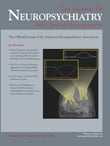Affective Prosopagnosia and “Hoccleve’s Complaint”
To the Editor: The poet and scribe, Thomas Hoccleve (1368–1426), a contemporary of Chaucer, evidently suffered from a severe form of affective psychosis. Some of the symptoms of his recurrent mood disorder are described in his poem, known as “Hoccleve’s Complaint.” Though formal diagnosis based on such self-disclosed, historical data cannot be made with confidence, some of Hoccleve’s descriptions suggest either a bipolar disorder with psychotic features or some form of schizoaffective disorder. For example, during what sound like depressive phases, Hoccleve describes feeling “sick and beaten/deserted by fortune,” so that “you practically swim in misery/And lose all delight in living.” 1 In contrast, during what appear to be manic periods or agitated catatonic states, Hoccleve describes himself (based on reports of contemporary observers) as
…like a wild bull/Crazed of expression/Holding my head from too high/Overbearing and proud in the brain/Like a six point stag. 1
Whatever the nature of the underlying disorder, Hoccleve describes a peculiar experience upon looking at his reflection in the mirror:
And when I got home, and found myself alone
And in my own room,
I struggled to the mirror,
To see if it was my face that stared back,
Or some other guy’s, someone not quite right,
Some vision that through
Cunning and force I could dispel. 1
Harrington et al. 2 described several neuropsychiatric syndromes characterized by disordered recognition and perception of human faces, including acute schizophrenia and mescaline-induced psychosis. They include so-called “affective prosopagnosia” or “stress-related dysfunctional face recognition” among these. They also describe the “mirror phenomenon,” which they define as
…the experience of inner alienation from one’s reflected face, which is perceived as independently alive, sinister, and generally physically distorted.” 2
Recently, fMRI studies have found evidence that “…a unique network involving frontoparietal structures” in the right hemisphere underlies self-face recognition 3 and that altered functional connectivity between frontoparietal networks and visual cortices is associated with major depression. 4
While retrospective inferences regarding Hoccleve’s diagnosis are fraught with risk, it is tempting to see his unusual “mirror experience” as related to such frontoparietal abnormalities, perhaps in the context of psychotic affective symptoms. Further research on abnormal self-face recognition and affective psychosis seems warranted.
1. Hoccleve T: Complaint (Free Verse translation by CJ Grindley). Available at www.arts.gla.ac.uk/SESLL/STELLA/COMET/glasgrev/issue4/hoccleve.htmGoogle Scholar
2. Harrington A, Oepen G, Spitzer M: Disordered recognition and perception of human faces in acute schizophrenia and experimental psychosis. Compr Psychiatry 1989; 30:376–384Google Scholar
3. Uddin LQ, Kaplan JT, Molnar-Szakacs I, et al: Self-face recognition activates a frontoparietal “mirror” network in the right hemisphere: an event-related fMRI study. Neuroimage 2005; 25:926–935Google Scholar
4. Desseilles M, Balteau E, Sterpenich V, et al: Abnormal neural filtering of irrelevant visual information in depression. J Neurosci 2009; 29:1395–1403Google Scholar



